Study of the Deformation by Compression of a Premolar with and Without Ceramic Restoration Using Speckle Optical Interferometry
Abstract
1. Introduction
2. Materials and Methods
2.1. Preparation of Healthy Premolars
2.2. Preparation of the CAD-CAM Ceramic Crown
2.3. Mechanical Device
2.4. Experimental Optical Arrangement
2.5. Measurements
3. Results and Discussion
4. Conclusions
Author Contributions
Funding
Institutional Review Board Statement
Informed Consent Statement
Data Availability Statement
Acknowledgments
Conflicts of Interest
Abbreviations
| DMI | Digital Moiré Interferometry |
| ESPI | Electronic Speckle Pattern Interferometry |
| CAD-CAM | Computer-Aided Design-Computer-Aided Manufacturing |
| μm | Micrometer |
| N | Newton |
| CMOS | Complementary Metal–Oxide–Semiconductor |
| GC | GC Corporation (Cerasmart material manufacturer) |
| He-Ne | Helium–Neon (laser type) |
References
- Magne, P.; Belser, U. Restauraciones de Porcelana Adherida en Los Dientes Anteriores: Método Biomimético; Editorial Quintessence: Barcelona, España, 2004; pp. 30–31. [Google Scholar]
- Baumgartner, A.; Dichtl, S.; Hitzenberger, C.K.; Sattmann, H.; Robl, B.; Moritz, A.; Fercher, A.F.; Sperr, W. Polarization-sensitive optical coherence tomography of dental structures. Caries Res. 2000, 34, 59–69. [Google Scholar] [CrossRef] [PubMed]
- Hwang, S.; Choi, Y.J.; Jung, S.; Kim, S.; Chung, C.J.; Kim, K.H. Posterior dental compensation and occlusal function in adults with different sagittal skeletal malocclusions. Korean J. Orthod. 2020, 50, 98–107. [Google Scholar] [CrossRef] [PubMed]
- Marin, B.; Makishi, P.; Sadr, A.; Shimada, Y.; Sumi, Y.; Tagami, J.; Giannini, M. Evaluation of bulk-fill systems: Microtensile bond strength and non-destructive imaging of marginal adaptation. Braz. Oral Res. 2018, 32, e80. [Google Scholar]
- Rivadeneira, C.; Bonifaz, E.A. Modelado de elementos finitos en dientes premolares. ACI Av. En Cienc. E Ing. 2013, 5. [Google Scholar] [CrossRef]
- Robinson, D.; Aguilar, L.; Gatti, A.; Abduo, J.; Vee Sin Lee, P.; Ackland, D. Load response of the natural tooth and dental implant: A comparative biomechanics study. J. Adv. Prosthodont. 2019, 11, 169–178. [Google Scholar] [CrossRef] [PubMed]
- Kishen, A.; Tan, K.; Asundi, A. Digital moiré interferometric investigations on the deformation gradients of enamel and dentine: An insight into non-carious cervical lesions. J. Dent. 2006, 34, 12–18. [Google Scholar] [CrossRef] [PubMed]
- Campos, L.; Parra, D.; Vasconcelos, M.; Vaz, M.; Monteiro, J. DH and ESPI laser interferometry applied to the restoration shrinkage assessment. Radiat. Phys. Chem. 2014, 94, 190–193. [Google Scholar] [CrossRef]
- Lang, H.; Rampado, M.; Müllejans, R.; Raab, W.H.M. Determination of the dynamics of restored teeth by 3D electronic speckle pattern interferometry. Lasers Surg. Med. 2004, 34, 300–309. [Google Scholar] [CrossRef] [PubMed]
- Zaslansky, P.; Currey, J.; Friesem, A.; Weiner, S. Phase shifting speckle interferometry for determination of strain and Young’s modulus of mineralized biological materials: A study of tooth dentin compression in water. J. Biomed. Opt. 2005, 10, 024020. [Google Scholar] [CrossRef] [PubMed]
- Barak, M.; Geiger, S.; Chattah, N.; Shahar, R.; Weiner, S. Enamel Dictates Whole Tooth Deformation: A Finite Element Model Study Validated by a Metrology Method. Available online: https://www.sciencedirect.com/science/article/abs/pii/S1047847709002056 (accessed on 24 March 2025).
- Fages, M.; Slangen, P.; Raynal, J.; Corn, S.; Turzo, K.; Margerit, J.; Cuisinier, F.J. Comparative mechanical behavior of dentin enamel and dentin ceramic junctions assessed by speckle interferometry (SI). Dent. Mater. 2012, 28, e229–e238. [Google Scholar] [CrossRef] [PubMed]
- Mendes, J.; de Oliveira, A.; Souto, A.; Nishioka, R.; Bottino, M.; Rodrigues, V. Effect of Framework Type on the Biomechanical Behavior of Provisional Crowns: Strain Gauge and Finite Element Analyses. Quintessence Int. 2020, 40, e9–e18. [Google Scholar]
- Araujo, F.; Favaro, L.; de Almeida, G.; Rodriguez, B.; Dantas, R.; Vinícius, P. Restorative material and loading type influence on the biomechanical behavior of wedge-shaped cervical lesions. Clin. Oral Investig. 2016, 20, 433–441. [Google Scholar]
- Rajpal, S.; Sirohi, R. Optical Methods of Measurement. Wholefield Techniques, 2nd ed.; CRC Press, Taylor and Francis Group: Boca Raton, FL, USA, 2009. [Google Scholar]
- Hecht, A.; Zajac, E. Optics; Addison Wesley Iberoamericana: Madrid, España, 2002. [Google Scholar]
- Fuentes, M.V.; Ceballos, L.; González-López, S. Bond strength of self-adhesive resin cements to different treated indirect composites. Clin. Oral Investig. 2013, 17, 717–724. [Google Scholar] [CrossRef] [PubMed]
- Inokoshi, M.; Nozaki, K.; Takagaki, T.; Okazaki, Y.; Yoshihara, K.; Minakuchi, S. Initial curing characteristics of composite cements under ceramic restorations. J. Prosthodont. Res. 2021, 65, 39–45. [Google Scholar] [CrossRef] [PubMed]
- Ditchburn, R.W. Light, 3rd ed.; Academic Press: London, UK, 1976. [Google Scholar]
- Sokal, R.; Rohlf, J. Biometry, 4th ed.; W.H. Freeman and Company: New York, NY, USA, 2011. [Google Scholar]
- Valín, J.; Vinícius, P.; de Almeida, G.; Palacios, F.; Palacios, G.; Pérez, J.; Valín, M. Development of the Moiré method of projecting fringes for the evaluation of deformations in upper premolars. Fund. Dialnet 2017, 20, 22–30. [Google Scholar]
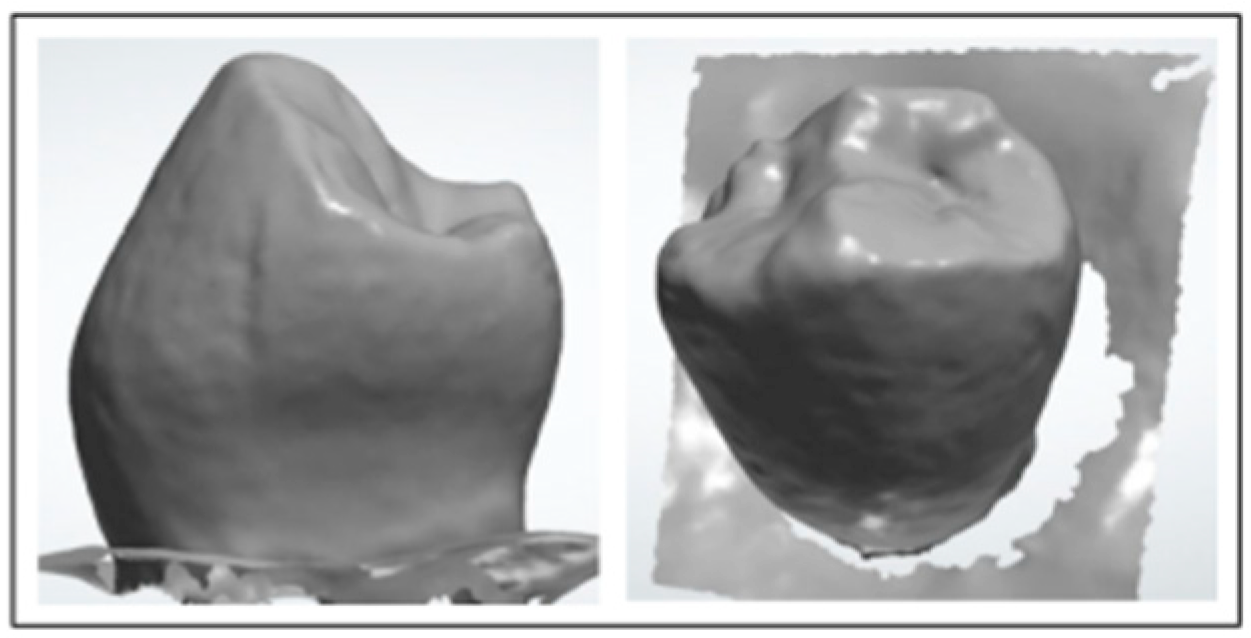
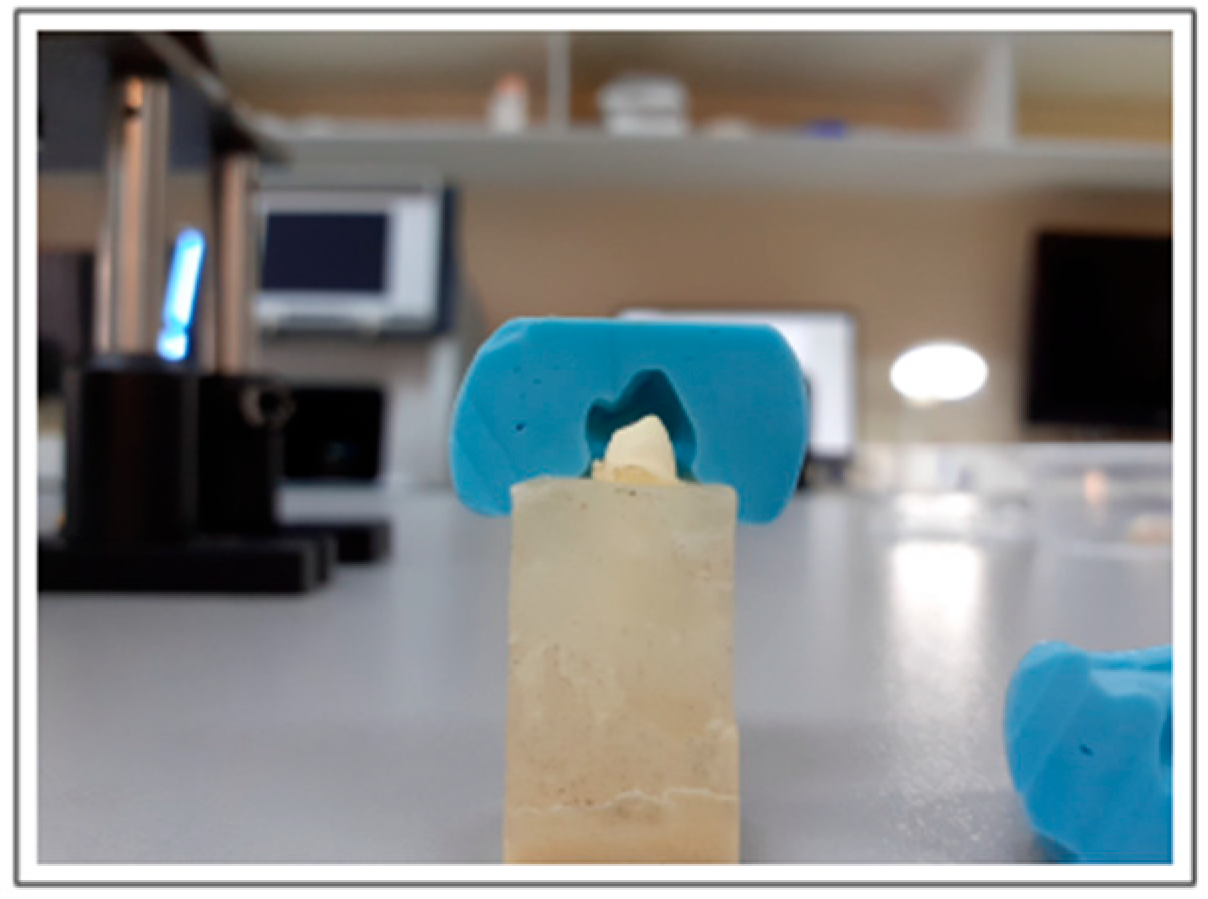
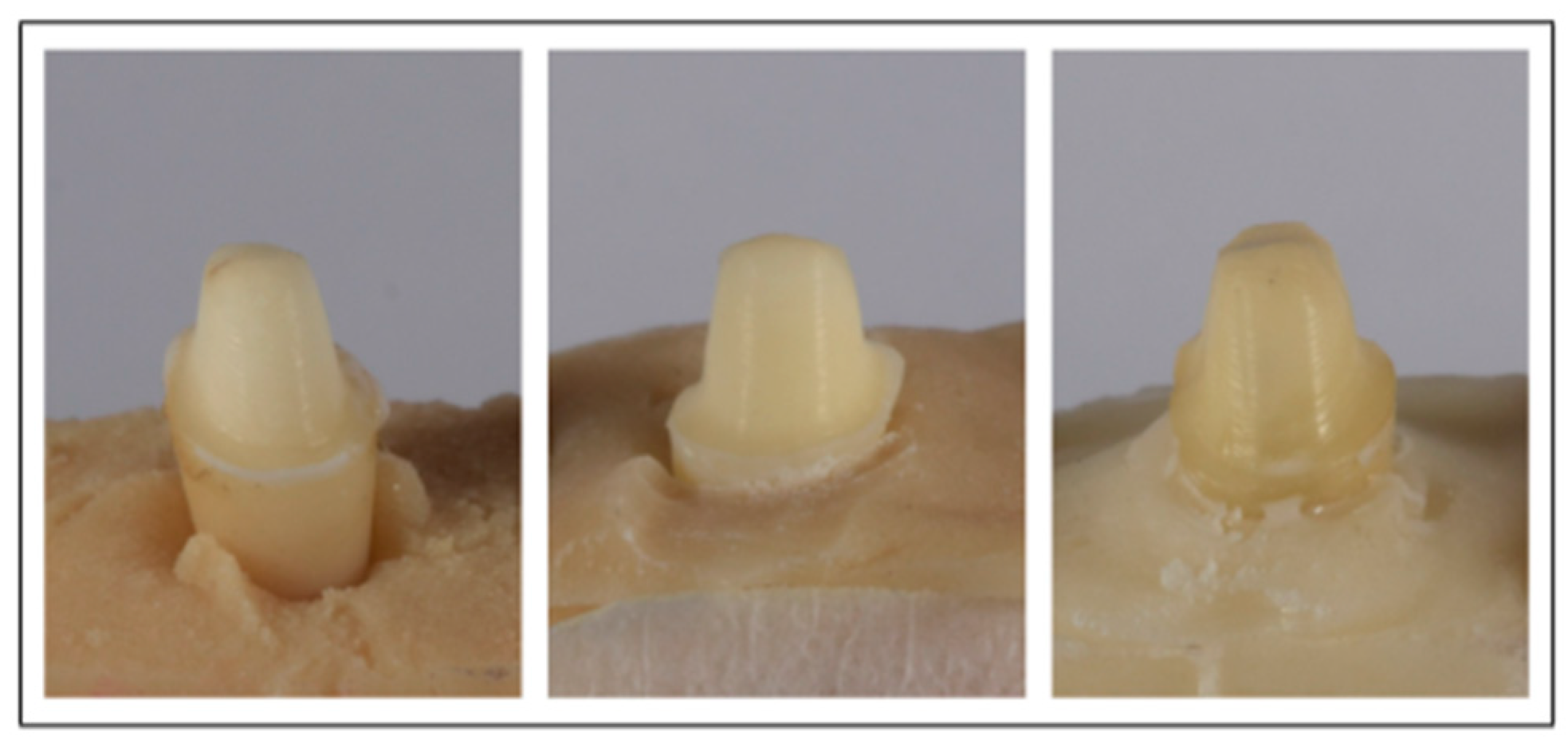


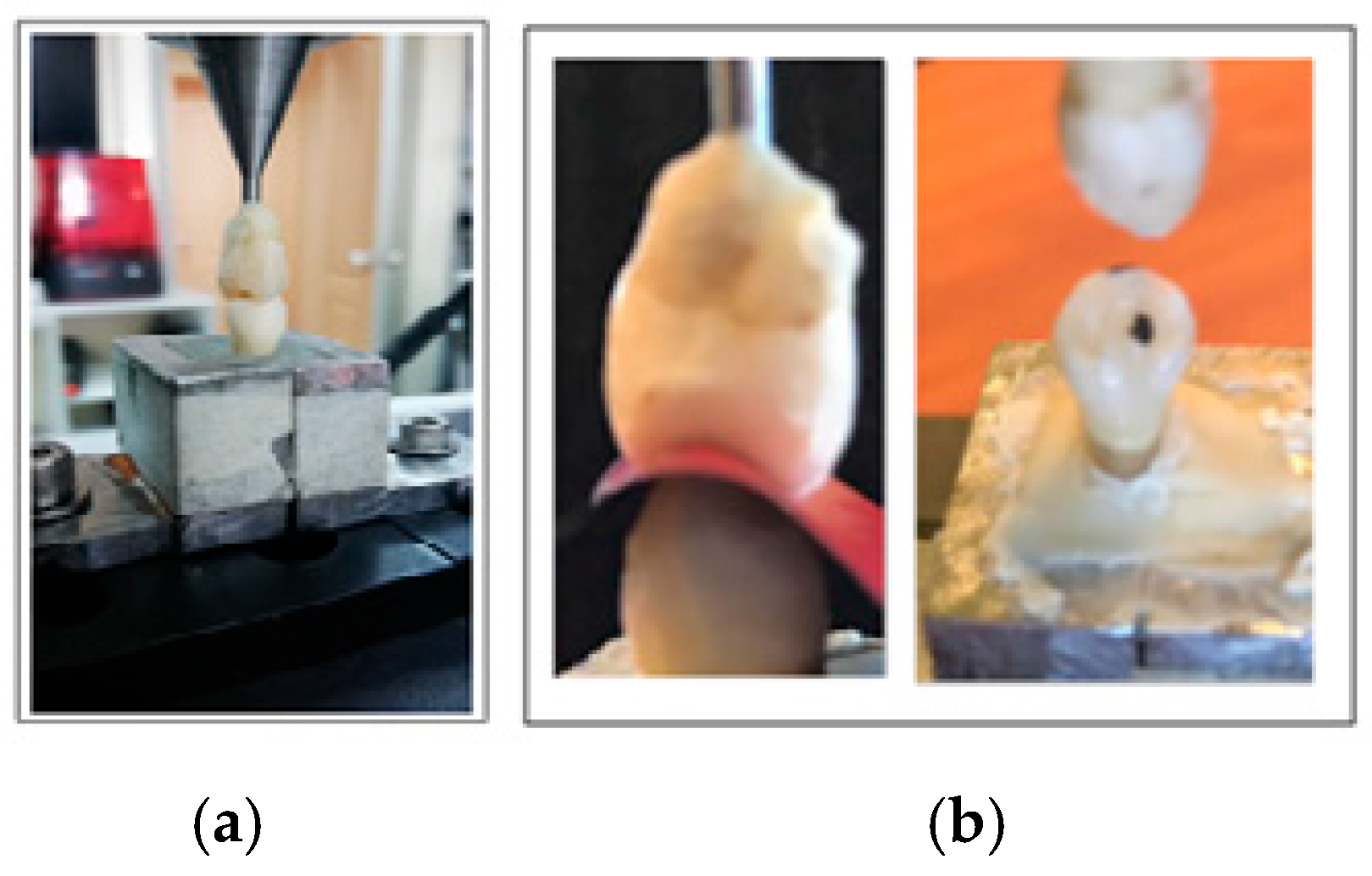
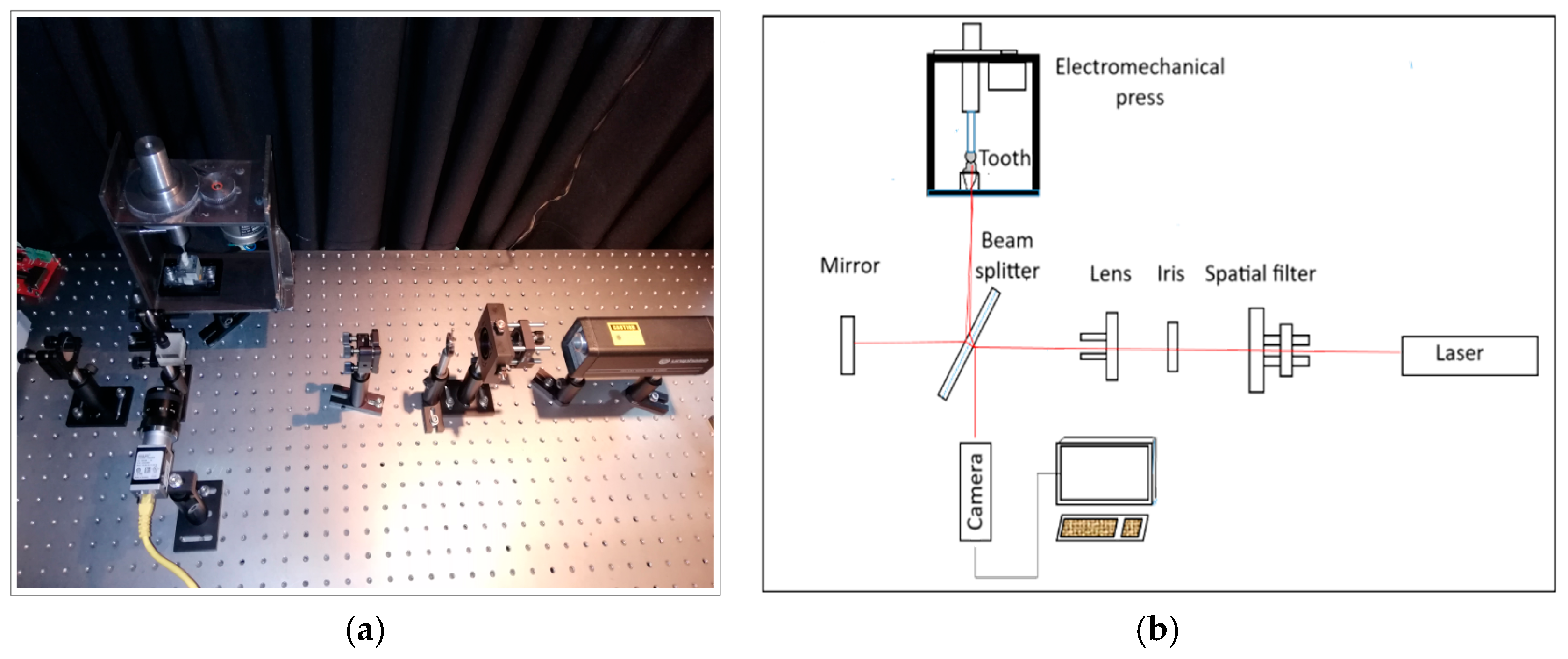


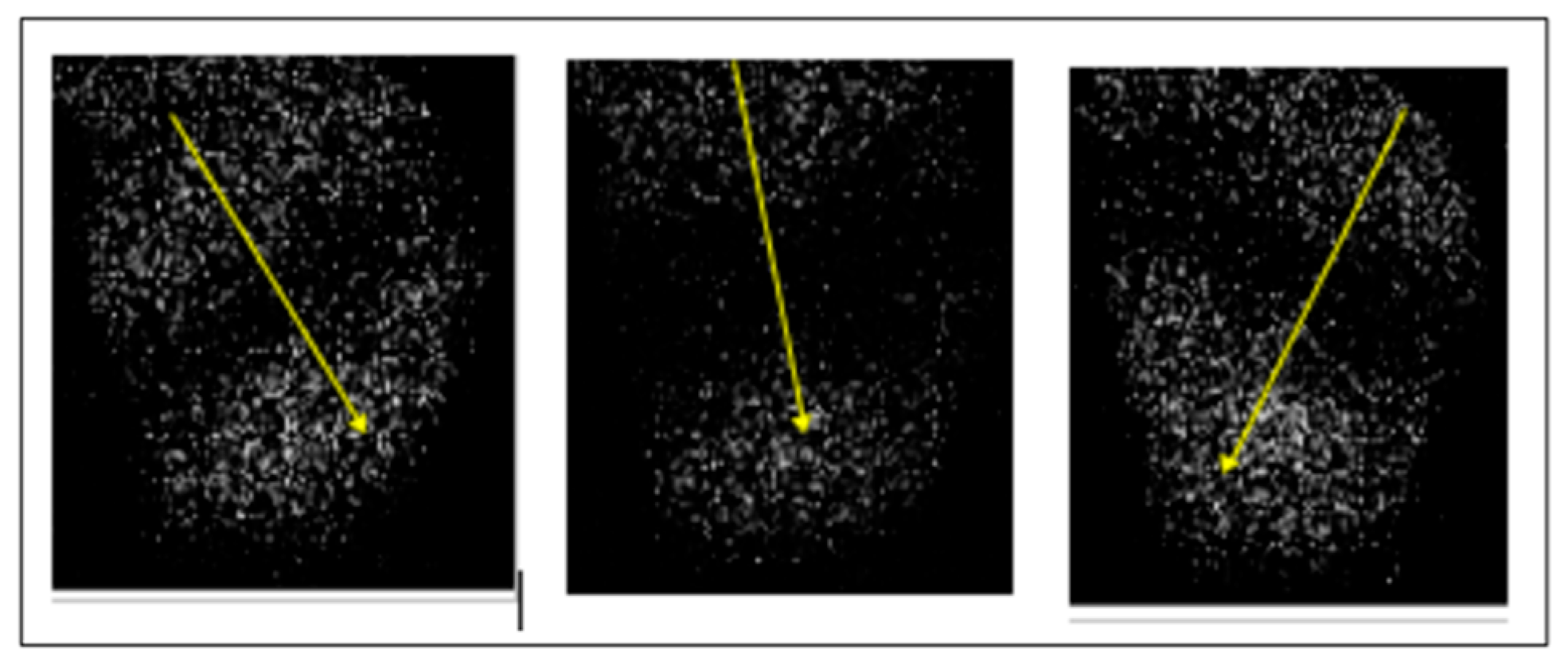
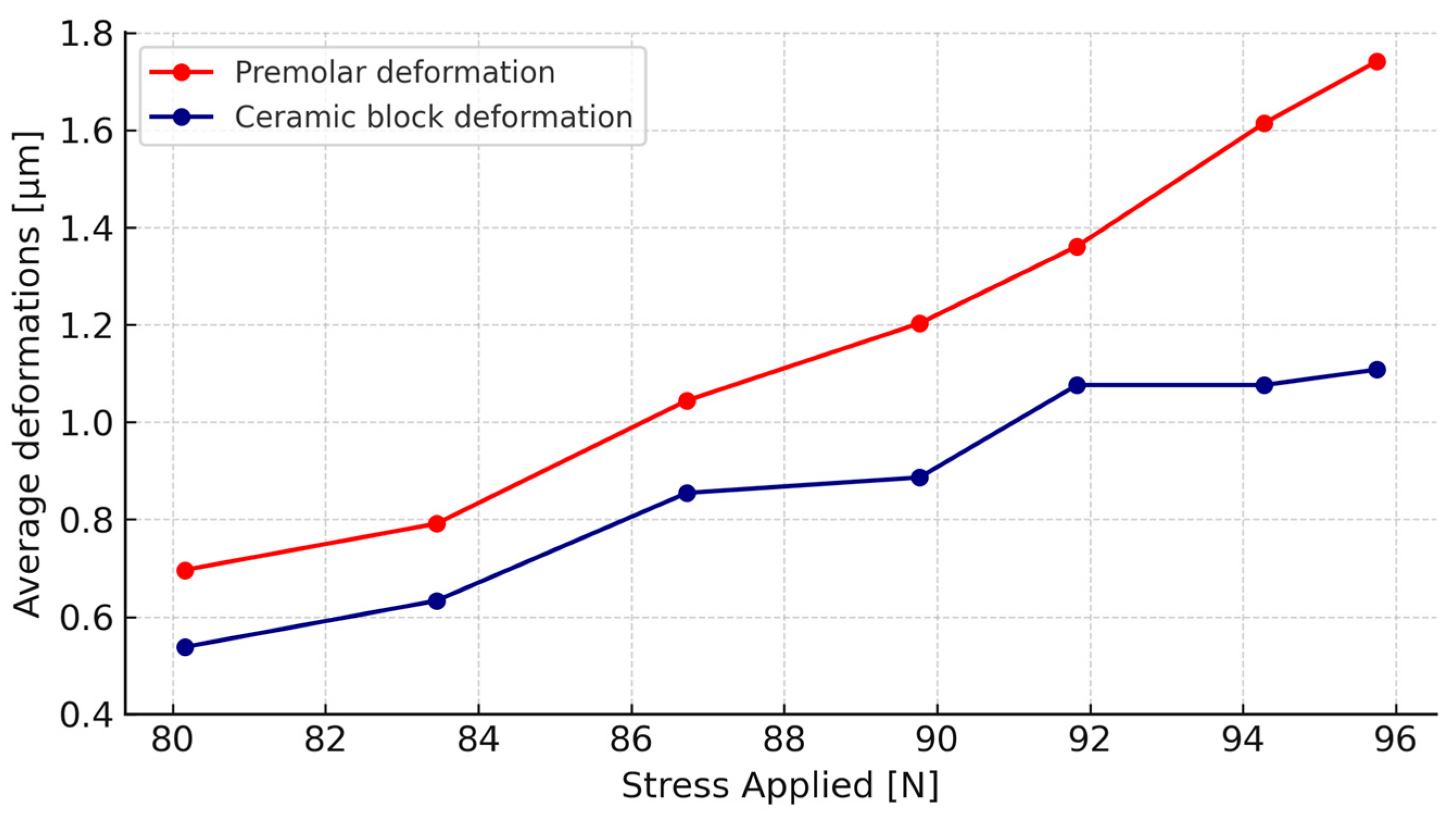
| Forces Applied [N] | Premolar Deformation [µm] | Ceramic Block Deformation [µm] | ||
|---|---|---|---|---|
| Mean | SD | Mean | SD | |
| 80.16 | 0.69630 | 0.13345 | 0.53805 | 0.21362 |
| 83.45 | 0.79125 | 0.22379 | 0.63300 | 0.14919 |
| 86.73 | 1.04445 | 0.26056 | 0.85455 | 0.15288 |
| 89.77 | 1.20270 | 0.29084 | 0.88620 | 0.20017 |
| 91.83 | 1.36095 | 0.26056 | 1.07610 | 0.21362 |
| 94.28 | 1.61415 | 0.27712 | 1.07610 | 0.16344 |
| 95.75 | 1.74075 | 0.22379 | 1.10775 | 0.22379 |
| Forces Applied [N] | Statistic Z | Effect Size | p-Value | |
|---|---|---|---|---|
| 80.16 | −1.518 | 0.48 | 0.129 | n.s. |
| 83.45 | −1.633 | 0.52 | 0.102 | n.s. |
| 86.73 | −2.121 | 0.67 | 0.034 | * |
| 89.77 | −2.308 | 0.73 | 0.021 | * |
| 91.83 | −2.714 | 0.86 | 0.007 | ** |
| 94.28 | −2.859 | 0.90 | 0.004 | ** |
| 95.75 | −2.694 | 0.85 | 0.007 | ** |
Disclaimer/Publisher’s Note: The statements, opinions and data contained in all publications are solely those of the individual author(s) and contributor(s) and not of MDPI and/or the editor(s). MDPI and/or the editor(s) disclaim responsibility for any injury to people or property resulting from any ideas, methods, instructions or products referred to in the content. |
© 2025 by the authors. Licensee MDPI, Basel, Switzerland. This article is an open access article distributed under the terms and conditions of the Creative Commons Attribution (CC BY) license (https://creativecommons.org/licenses/by/4.0/).
Share and Cite
Baradit, E.; Gutiérrez, J.; Yáñez, M.; Sumonte, C.; Aguilera, C. Study of the Deformation by Compression of a Premolar with and Without Ceramic Restoration Using Speckle Optical Interferometry. Appl. Sci. 2025, 15, 10708. https://doi.org/10.3390/app151910708
Baradit E, Gutiérrez J, Yáñez M, Sumonte C, Aguilera C. Study of the Deformation by Compression of a Premolar with and Without Ceramic Restoration Using Speckle Optical Interferometry. Applied Sciences. 2025; 15(19):10708. https://doi.org/10.3390/app151910708
Chicago/Turabian StyleBaradit, Erik, Jorge Gutiérrez, Miguel Yáñez, Claudio Sumonte, and Cristhian Aguilera. 2025. "Study of the Deformation by Compression of a Premolar with and Without Ceramic Restoration Using Speckle Optical Interferometry" Applied Sciences 15, no. 19: 10708. https://doi.org/10.3390/app151910708
APA StyleBaradit, E., Gutiérrez, J., Yáñez, M., Sumonte, C., & Aguilera, C. (2025). Study of the Deformation by Compression of a Premolar with and Without Ceramic Restoration Using Speckle Optical Interferometry. Applied Sciences, 15(19), 10708. https://doi.org/10.3390/app151910708






